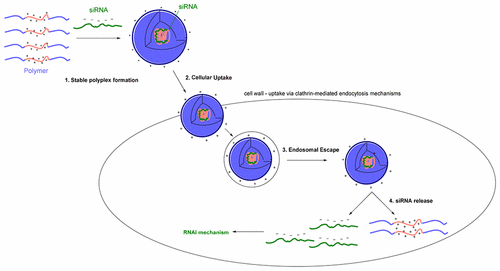当前位置:
X-MOL 学术
›
Biomacromolecules
›
论文详情
Our official English website, www.x-mol.net, welcomes your
feedback! (Note: you will need to create a separate account there.)
Glycosylated Reversible Addition–Fragmentation Chain Transfer Polymers with Varying Polyethylene Glycol Linkers Produce Different Short Interfering RNA Uptake, Gene Silencing, and Toxicity Profiles
Biomacromolecules ( IF 5.5 ) Pub Date : 2017-11-09 00:00:00 , DOI: 10.1021/acs.biomac.7b01168 Elizabeth G. L. Williams 1 , Oliver E. Hutt 1 , Tracey M. Hinton 2 , Sophie C. Larnaudie 1 , Tam Le 1 , James M. MacDonald 1 , Pathiraja Gunatillake 1 , San H. Thang 1 , Peter J. Duggan 1, 3
Biomacromolecules ( IF 5.5 ) Pub Date : 2017-11-09 00:00:00 , DOI: 10.1021/acs.biomac.7b01168 Elizabeth G. L. Williams 1 , Oliver E. Hutt 1 , Tracey M. Hinton 2 , Sophie C. Larnaudie 1 , Tam Le 1 , James M. MacDonald 1 , Pathiraja Gunatillake 1 , San H. Thang 1 , Peter J. Duggan 1, 3
Affiliation

|
Achieving efficient and targeted delivery of short interfering (siRNA) is an important research challenge to overcome to render highly promising siRNA therapies clinically successful. Challenges exist in designing synthetic carriers for these RNAi constructs that provide protection against serum degradation, extended blood retention times, effective cellular uptake through a variety of uptake mechanisms, endosomal escape, and efficient cargo release. These challenges have resulted in a significant body of research and led to many important findings about the chemical composition and structural layout of the delivery vector for optimal gene silencing. The challenge of targeted delivery vectors remains, and strategies to take advantage of nature’s self-selective cellular uptake mechanisms for specific organ cells, such as the liver, have enabled researchers to step closer to achieving this goal. In this work, we report the design, synthesis, and biological evaluation of a novel polymeric delivery vector incorporating galactose moieties to target hepatic cells through clathrin-mediated endocytosis at asialoglycoprotein receptors. An investigation into the density of carbohydrate functionality and its distance from the polymer backbone is conducted using reversible addition–fragmentation chain transfer polymerization and postpolymerization modification.
中文翻译:

具有各种聚乙二醇接头的糖基化可逆加成-断裂链转移聚合物可产生不同的短干扰RNA吸收,基因沉默和毒性谱
实现短干扰(siRNA)的有效和靶向递送是一项重要的研究挑战,需要克服,以使临床上高度有希望的siRNA治疗取得成功。为这些RNAi构建体设计合成载体时面临挑战,这些载体可提供抗血清降解,延长血液保留时间,通过多种吸收机制有效吸收细胞,内体逃逸以及有效货物释放的保护作用。这些挑战导致了大量的研究,并导致了许多有关最佳基因沉默的传递载体化学组成和结构布局的重要发现。靶向递送载体的挑战仍然存在,并且利用自然界对特定器官细胞(例如肝脏)的自我选择细胞摄取机制的策略,使研究人员能够更进一步地实现这一目标。在这项工作中,我们报告设计,合成和生物学评估结合半乳糖部分通过网格蛋白介导的去唾液酸糖蛋白受体内吞作用靶向肝细胞的半乳糖部分。使用可逆的加成-断裂链转移聚合和后聚合改性技术,研究了碳水化合物官能度的密度及其与聚合物主链的距离。
更新日期:2017-11-09
中文翻译:

具有各种聚乙二醇接头的糖基化可逆加成-断裂链转移聚合物可产生不同的短干扰RNA吸收,基因沉默和毒性谱
实现短干扰(siRNA)的有效和靶向递送是一项重要的研究挑战,需要克服,以使临床上高度有希望的siRNA治疗取得成功。为这些RNAi构建体设计合成载体时面临挑战,这些载体可提供抗血清降解,延长血液保留时间,通过多种吸收机制有效吸收细胞,内体逃逸以及有效货物释放的保护作用。这些挑战导致了大量的研究,并导致了许多有关最佳基因沉默的传递载体化学组成和结构布局的重要发现。靶向递送载体的挑战仍然存在,并且利用自然界对特定器官细胞(例如肝脏)的自我选择细胞摄取机制的策略,使研究人员能够更进一步地实现这一目标。在这项工作中,我们报告设计,合成和生物学评估结合半乳糖部分通过网格蛋白介导的去唾液酸糖蛋白受体内吞作用靶向肝细胞的半乳糖部分。使用可逆的加成-断裂链转移聚合和后聚合改性技术,研究了碳水化合物官能度的密度及其与聚合物主链的距离。











































 京公网安备 11010802027423号
京公网安备 11010802027423号